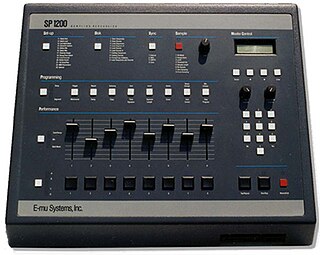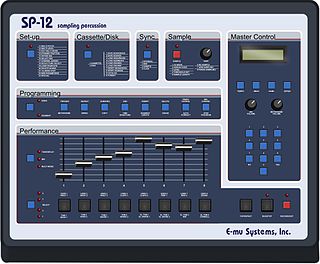
Digital music technology encompasses the use of digital instruments to produce, perform or record music. These instruments vary, including computers, electronic effects units, software, and digital audio equipment. Digital music technology is used in performance, playback, recording, composition, mixing, analysis and editing of music, by professions in all parts of the music industry.

An analog synthesizer is a synthesizer that uses analog circuits and analog signals to generate sound electronically.
Akai is a Hong Kong-based manufacturer of consumer electronics. It was established as Akai Electric Company Ltd in Tokyo, Japan, in 1946.
A music workstation is an electronic musical instrument providing the facilities of:

A sampler is an electronic musical instrument that records and plays back samples. Samples may comprise elements such as rhythm, melody, speech, sound effects or longer portions of music.

The Roland TR-909 Rhythm Composer, commonly known as the 909, is a drum machine introduced by Roland Corporation in 1983, succeeding the TR-808. It was the first Roland drum machine to use samples for some sounds, and the first with MIDI functionality, allowing it to synchronize with other devices. Though a commercial failure, it influenced the development of electronic dance music genres such as techno, house and acid house.

The Roland MT-32 Multi-Timbre Sound Module is a MIDI synthesizer module first released in 1987 by Roland Corporation. It was originally marketed to amateur musicians as a budget external synthesizer with an original list price of $695. However, it became more famous along with its compatible modules as an early de facto standard in computer music. Since it was made prior to the release of the General MIDI standard, it uses its own proprietary format for MIDI file playback.

The Emulator is a series of digital sampling synthesizers using floppy-disk storage that was manufactured by E-mu Systems from 1981 until 2002. Although it was not the first commercial sampler, the Emulator was innovative in its integration of computer technology and was among the first samplers to find widespread usage among musicians. While costly, its price was considerably lower than those of its early competitors, and its smaller size increased its portability and, resultantly, practicality for live performance. The line was discontinued in 2002.
The Akai S900 is a 12-bit sampler, with a variable sample rate from 7.5 kHz through to 40 kHz. It was common in recording studios until it was superseded two years later by the S1000.

Simmons is an electronic drum brand, which originally was a pioneering British manufacturer of electronic drums. Founded in 1978 by Dave Simmons, it supplied electronic kits from 1980 to 1998. The drums' distinctive, electronic sound can be found on countless albums from the 1980s. The company closed in 1999 and the Simmons name is currently owned by Guitar Center.

The E-mu SP-1200 is a sampling drum machine designed by Dave Rossum and released in August 1987 by E-mu Systems. Like its predecessor, the SP-12, it was designed as a drum machine featuring user sampling. The distinctive character of its sound, often described as "warm," "dirty," and "gritty," and attributed to SP-1200's low 26.04 kHz sampling rate, 12-bit sampling resolution, drop-sample pitch-shifting, and analog SSM2044 filter chips (ICs), has sustained demand for the SP-1200 more than thirty-five years after its debut, despite the availability of digital audio workstations and samplers/sequencers with superior technical specifications.

The Korg DSS-1 is a polyphonic sampling synthesizer released by Korg in 1986. As Korg's initial entry into the sampling market, the DSS-1 combines sampling, additive synthesis, and waveform drawing with an analog signal path. The DSS-1 was released a time when major synthesizer manufacturers like Yamaha and Casio were beginning to explore sampling, an area of sound design dominated by companies like Fairlight, E-mu, and Ensoniq. Korg did not stay long in the sampling arena; the DSS-1 was the company's only sampler until 1998 when Korg introduced sampling options on their Triton and Trinity series of workstations.

The Roland TR-707 Rhythm Composer is a drum machine released by Roland Corporation in 1985.
The Prophet 2000 is a sampler keyboard manufactured by Dave Smith's Sequential Circuits (SCI) and released in 1985. It was the company's first sampler, and, despite its low audio fidelity and technical limitations by modern standards, marked a shift toward affordable samplers with better audio quality than its predecessors. It is also considered to be one of the earliest multitimbral samplers.

The E-mu SP-12 is a sampling drum machine. Designed in 1984, SP-12 was announced by E-mu Systems in 1985. Expanding on the features of E-mu’s affordable and commercially successful Drumulator, a programmable digital drum machine, SP-12 introduced user sampling, enabling musicians to sample their own drums and other sounds. In August 1987, E-mu replaced SP-12 with SP-1200.

The Roland S-50 is a 61-key 12-bit sampler keyboard produced by the Roland Corporation in 1986. It featured a 3.5-inch DSDD floppy disk drive and had external CRT monitor support to facilitate editing of samples. It could hold up to 32 samples. A rack-mounted version was also available, which featured expanded memory.
The Kawai K4 is a 61 key synthesizer manufactured in 1989 by Kawai. It contains several features beyond those offered on Kawai K1, adding resonant filters and a DAC PCM wavetable. The K4 incorporated a new type of synthesis called Digital Multi Spectrum.

The DDD-1 is a sampling drum machine released by Korg in 1986. It was Korg's first drum machine equipped with MIDI control and it features 14 velocity-sensitive pads, 12-bit samples, and limited user sampling that allows for the addition of new sounds. It also offers sound expansion through ROM cards, six assignable audio outputs, and a backlit LCD display.

The Drumtraks, also referred to as the Drumtraks Model 400, is a drum machine released by the American company Sequential in 1984. It was one of first drum machines on the market to feature MIDI control, after the Roland TR-909.

















